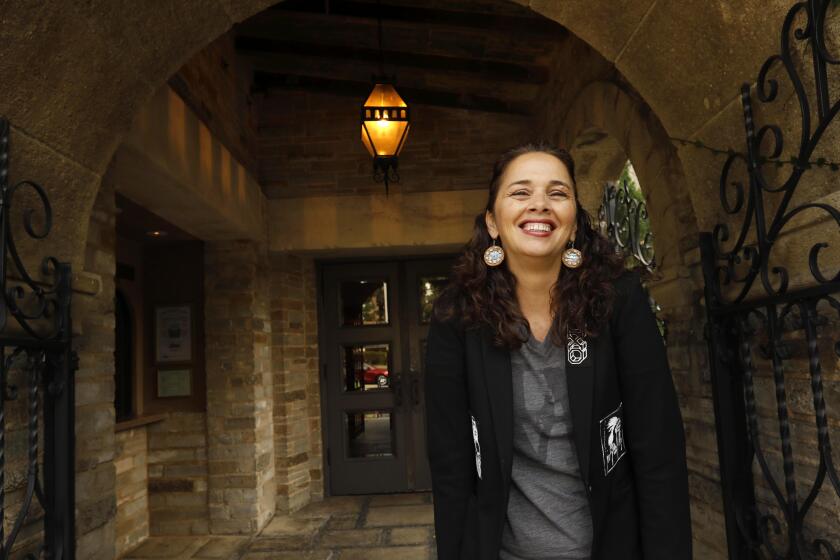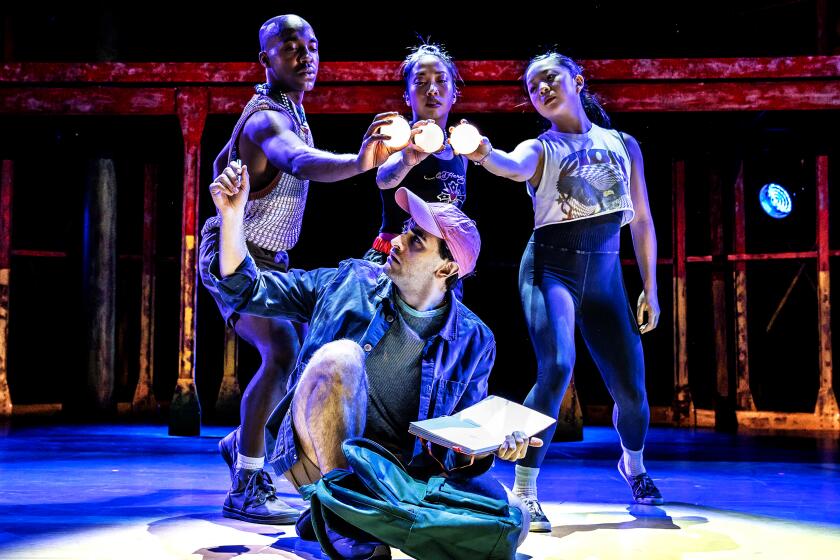The Calder Quartet is always ready to stretch boundaries
Six years ago, soon after the foursome that makes up the Calder Quartet graduated from USC, the group began to get noticed.
Even those who saw these young men as a bit green thought they might be on their way to something big. The critic Alan Rich, not known for dispensing praise lightly, called the Calders a new hope for a resident quartet in L.A. With good looks, mainstream musical flair and earnest ambition, the group was on many observers’ most-likely-to list.
But those who knew how hard it is to hold a chamber group together -- for financial, musical and personal reasons -- tempered their hopes. Their mentor at USC’s conservatory of music, Peter Marsh, was one of them.
“Some people say it has all of the disadvantages -- and none of the advantages -- of marriage,” he said. “How can it possibly work?”
Somehow, the Calders experiment has, in spite of the pressures, worked. In the last year or so the quartet has appeared as accompanists on “Late Show With David Letterman,” at the Coachella Music and Arts Festival and at clubs including the El Rey and New York’s Webster Hall, all accompanying the band the Airborne Toxic Event.
In October they made their European debut, thanks to an invitation from composer Thomas Adès to perform his music in Stockholm.
On Friday, they perform with Airborne at Walt Disney Concert Hall as part of the Los Angeles Philharmonic’s West Coast, Left Coast festival. The group performs on its own the following Friday at the Colburn School.
They are hardly one of the nation’s big-time chamber groups. But after 11 years, violinists Ben Jacobson and Andrew Bulbrook, cellist Eric Byers -- all 29 -- and violist Jonathan Moerschel, 30, are still together, still talking to one another and still expanding their musical horizons.
The dynamic by which a group or relationship of any kind works or falls apart remains mysterious. But the Calders say they’ve learned something about keeping such a precarious marriage functioning.
One key, the four agree, is keeping their musical lives unpredictable and various. “Doing the same thing, all the time, now matter how good it is, can seem like a grind,” says Moerschel. The Calders were brought together by their love of Austro-German composers like Haydn and Beethoven. But they’re a long way from wigs and candles now: The group recently completed a tour with Andrew W.K., whose music -- somewhere between hard rock and the avant-garde -- is not a natural choice for a classical ensemble.
Byers recalls the audience’s benign confusion at a recent club show. “Whether they were heavy metal fans or classical enthusiasts,” he says, “they showed up and didn’t know what was going on. And still liked it, it seemed like. And the week before that, we were playing Schubert.”
Playing with rock bands isn’t the only change in the Calders’ musical diet over the last few years, but it’s one of the most genuinely challenging, and it’s one way they’re setting themselves apart from other young groups.
A new union
It’s also not the only way they’ve kept things fresh for themselves. “Something we decided pretty early on is that everyone stop living together,” says Bulbrook, the group’s most outgoing member. “Even at summer festivals and that kind of thing.”
During a move to New York in 2005 to serve as string-quartet-in-residence at Juilliard for two years, they lived in separate neighborhoods.
Still, a turning point for the group came in May 2008, when the members of Airborne -- a group based around Los Feliz and named for a phrase of Don DeLillo’s -- came to see the Calder play the music of Adès.
“I remember seeing them at Disney Hall and getting completely floored by the intricacy of what they were doing,” says singer Mikel Jollett, who calls himself a classical neophyte. “The way they could move together just blew my mind. The tempo and rhythm changes on such difficult material -- on a dime. I didn’t quite understand what was going on.”
Airborne showed up in part because Bulbrook’s sister, Anna, plays in the rock band. The fruit of this mutual enthusiasm has been a series of YouTube videos between the groups, and numerous shows. All four of the Calders have enjoyed this collaboration, though it was not easy. Moerschel, for instance, made his first trip to a rock club the night the groups played together at the El Rey.
“The form and structure is significantly simpler than what we’re used to,” the violist says. “But the aesthetic, the logistics, are just so completely different. It’s a whole day of loading in, sound checks, making sure all the electronics work, the cables. . . . And when you play behind rock musicians, or improvisers, you have to be totally on your toes, ready for a sudden change.”
Jollett says the Calders have fully gotten into the sprit of things. At the Webster Hall gig, he says, Bulbrook wore a cowboy hat and threw beer like an old-school rock star.
Varied tastes
Unlike a rock band or pop ensembles based on self-penned material -- string quartets typically define themselves by which part of the chamber-music repertoire they’re drawn to. Some groups express themselves through a sound or style -- burnished and elegiac for the Guarneri Quartet, firm and muscular for the Emerson Quartet -- but they’re all associated with what they play.
This is another way the Calders have stretched out recently. With W.K., for instance, they played John Cage’s “4’33” “ -- a landmark piece made up entirely of silence -- to a mostly baffled audience.
They’ve long been drawn to the neo-romantic composer Christopher Rouse and premiere his third string quartet in New Haven, Conn., next spring. In 2011, they make their Carnegie Hall debut with the piece. And February will see the launch of their Bartók Cycle, at UC Riverside, which they hope to play for years to come.
Their relationship with Adès -- a longtime enfant terrible of English music -- is deepening, and the composer has invited the group to perform with him in Melbourne, Australia.
In the fall they performed a quartet by experimental composer and guitarist Fred Frith. Jacobson was the main impetus here: He jokes that he put on CDs of Frith’s music at every possible occasion to subliminally persuade the group to perform it.
As they’ve moved deeper into contemporary music, the Calders have also recommitted to the pieces that brought them together -- Haydn, Beethoven and Mendelssohn. They’ve made several trips to Berlin to study and rehearse in a home owned by Mendelssohn’s family. And these days they’re listening most intently to old European chamber groups, such as the Amadeus, Alban Berg and Vegh quartets.
The Berlin trips have taught them -- by way of a German teacher who does not know English -- a different kind of pedagogy than they’re used to from USC or Juilliard. “He’s yelling at you because you’re not getting it fast enough,” Bulbrook recalls, “and yelling at the translator because she’s not translating it correctly. For five hours straight.”
The success they’ve had doesn’t encourage them to relax. “It’s kind of the nature of the beast of what we do,” says Bulbrook. “As your understanding increases, or you get better at it, the horizon always kind of stays the same distance away. As you grow you’re getting better, but you’re always hearing more possibilities.
“At one level it’s agonizing, but at another level it’s completely fascinating -- to always be struggling to fully understand what you’re gonna play.”
scott-timberg.blogspot.com
More to Read
The biggest entertainment stories
Get our big stories about Hollywood, film, television, music, arts, culture and more right in your inbox as soon as they publish.
You may occasionally receive promotional content from the Los Angeles Times.





